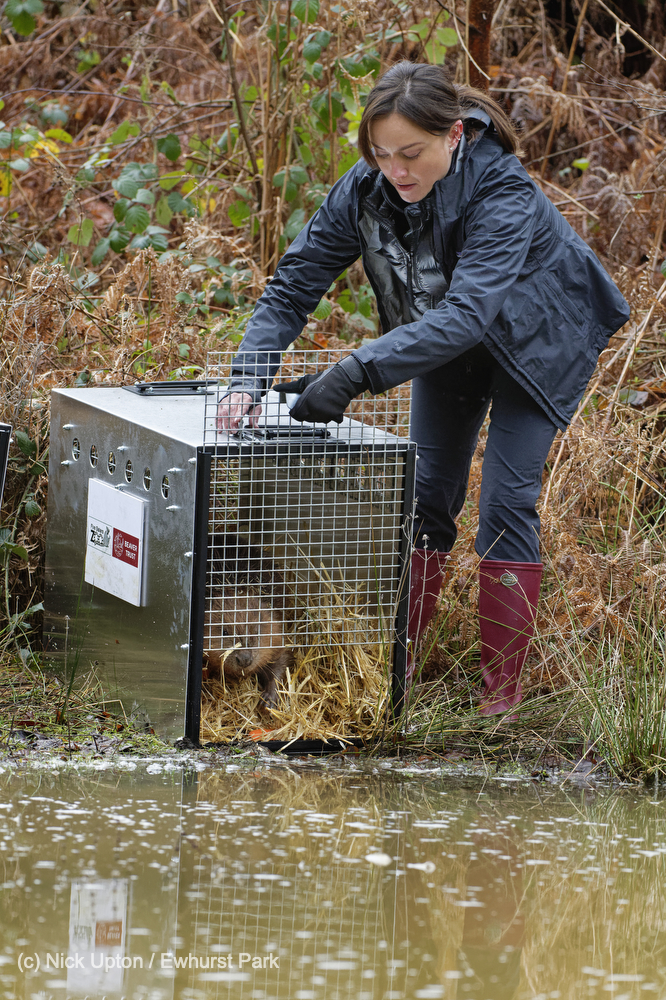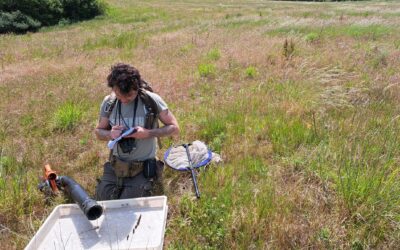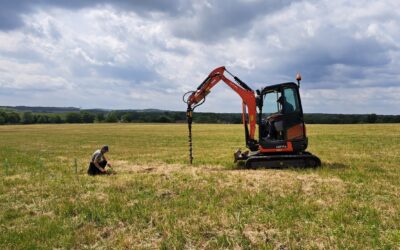We are celebrating a significant milestone at Ewhurst Park. This January, two beavers were released into the park – making this the first time beavers have been seen in Hampshire in 400 years.
This is significant for a couple of reasons. First, the introduction of beavers is a key part of the biodiversity project here at Ewhurst Park, and, second, their arrival is part of a wider government initiative to restore the country’s natural environment – something we desperately need in this era of environmental depletion.
The beavers – who we are calling Hazel and Chompy, having held a naming competition in local schools – came from Scotland’s Tay Valley, where a wild population is thriving following their introduction in 2009.

Arrival at Ewhurst Park – putting a toe in the water!
They travelled down in separate transport cases then were released one at a time into their new home: a specially created seven-acre enclosure, with three ponds.
First out was Hazel, the female. It was a delightful moment! She immediately swam out and started exploring. Then came Chompy, the male, who was equally curious. They were very calm. They investigated the environment, looking quite comfortable. Within minutes, they had found each other and started playing, which was wonderful to see. Now, we’re hoping they will mate and establish a beaver community.
We hope one day you will come and see them for yourselves. Once the landscape recovery is underway, we plan to invite more visitors to Ewhurst Park – our goal is to inspire people to learn about the natural world and reconnect with nature. In the meantime, we have cameras in the beaver enclosure – these are not online yet, but we’re able check in to see what they’re up to.
Beavers are amazing creatures. They’ve been called nature’s landscape architects. They are most active at night, working up to 12 hours at a time busily building dams and lodges for protection and create give shelter for their offspring, which are called kits.

Here I am releasing one of our new residents into the beaver enclosure.
Their presence rejuvenates the environment. To make their dams, they take down and use old and dead trees, which creates space for healthy trees. They are what’s known as a ‘keystone species’, meaning they play an important role in increasing biodiversity – their dams create wetlands in which insects and plants can thrive, and this in turn attracts birds and animals, like water voles. Their activity reduces water pollution and has been shown to prevent flooding, and water gets retained in times of drought.
This journey has been an amazing experience. We have been working with the Beaver Trust to make sure Ewhurst Park is a suitable location, and we will continue to observe and monitor the beavers as they settle into their new home. Eventually, we hope to give them more freedom to roam.
Happily, beavers are now a protected species. Four hundred years ago, they were hunted to extinction for their fur, which was used in clothing, and their glands, which produce a chemical that can be used in perfume. They were also hunted for their meat.
Unfortunately, there is some controversy and confusion around beavers. Firstly, contrary to popular belief, they are herbivores, meaning they don’t eat fish or animals, so no creatures are at risk. Secondly, while some have claimed beavers can cause flooding, in fact, studies show their activity prevents flooding. We are in dialogue with our neighbours about their introduction: everything is being closely monitored and controlled to make sure everything goes smoothly.
While this is a great milestone for Ewhurst Park, there is also a wider significance. At this moment in time, we have an opportunity to consider what sort of environment we want to live in. Despite the hard work of conservationists, England is struggling to retain its natural landscapes, in all its biodiversity and beauty. Ewhurst Park is just one of many initiatives supported by the government’s Countryside Stewardship scheme that is seeking to restore the landscape. The arrival of these beavers offers hope that steps are being taken in the right direction – we’re restoring places for nature and playing our role as part of the enormous challenge we all face in combating the climate crisis.




